How Social Media Transforms Business: Communication and Performance
VerifiedAdded on 2023/06/04
|12
|3057
|308
Report
AI Summary
This report examines the multifaceted impact of social media on business communication and organizational efficiency. It highlights how platforms like Facebook, Twitter, and LinkedIn enhance work performance, improve employee engagement, facilitate knowledge sharing, and promote transparency. The report synthesizes findings from various peer-reviewed studies, demonstrating that strategic use of social media can lead to increased productivity, better crisis management, and enhanced collaboration within the workplace. It also addresses potential drawbacks, such as privacy concerns and work-related conflicts, while emphasizing the importance of establishing clear guidelines for social media use to maximize its benefits in a business context. Desklib provides access to this report along with a wide array of study resources, including past papers and solved assignments.
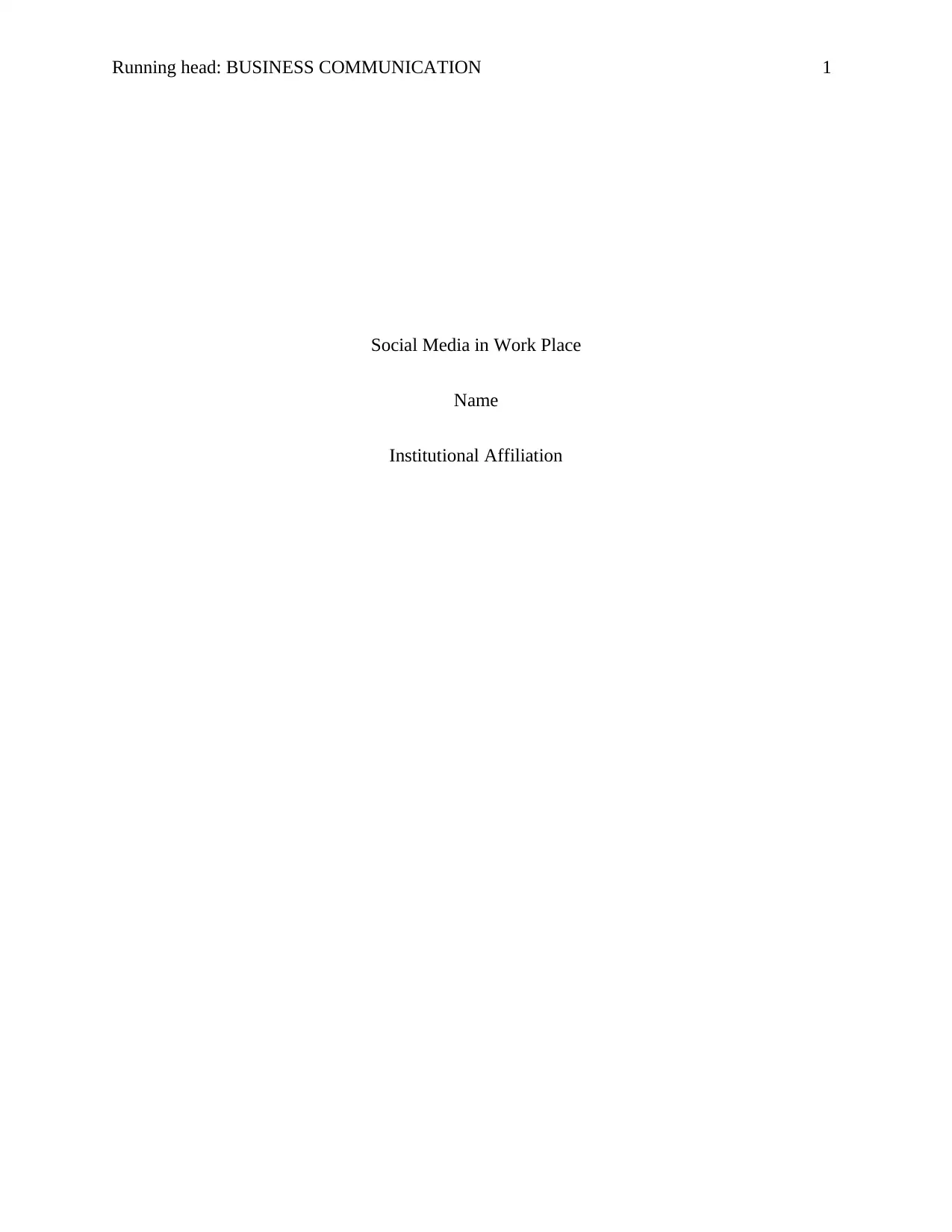
Running head: BUSINESS COMMUNICATION 1
Social Media in Work Place
Name
Institutional Affiliation
Social Media in Work Place
Name
Institutional Affiliation
Paraphrase This Document
Need a fresh take? Get an instant paraphrase of this document with our AI Paraphraser
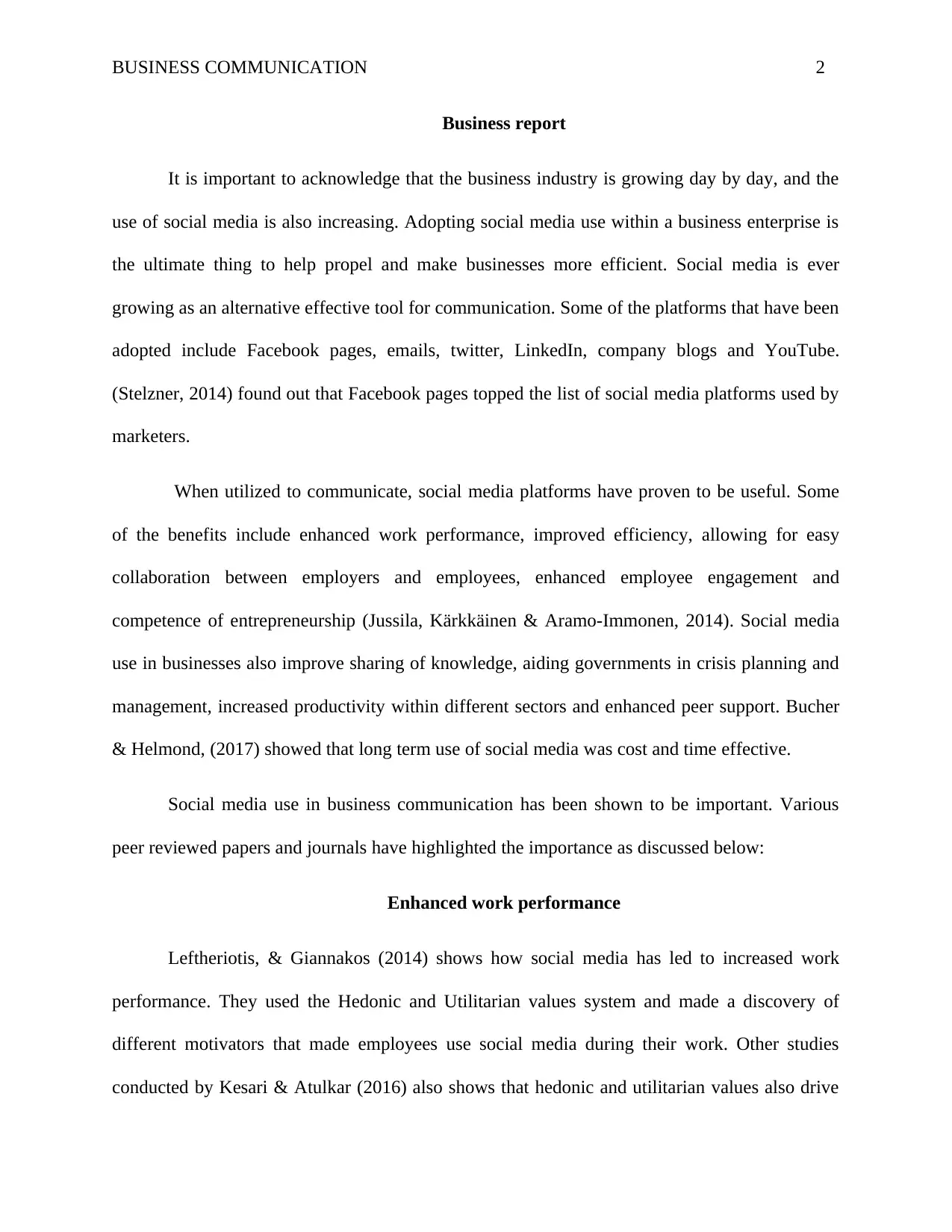
BUSINESS COMMUNICATION 2
Business report
It is important to acknowledge that the business industry is growing day by day, and the
use of social media is also increasing. Adopting social media use within a business enterprise is
the ultimate thing to help propel and make businesses more efficient. Social media is ever
growing as an alternative effective tool for communication. Some of the platforms that have been
adopted include Facebook pages, emails, twitter, LinkedIn, company blogs and YouTube.
(Stelzner, 2014) found out that Facebook pages topped the list of social media platforms used by
marketers.
When utilized to communicate, social media platforms have proven to be useful. Some
of the benefits include enhanced work performance, improved efficiency, allowing for easy
collaboration between employers and employees, enhanced employee engagement and
competence of entrepreneurship (Jussila, Kärkkäinen & Aramo-Immonen, 2014). Social media
use in businesses also improve sharing of knowledge, aiding governments in crisis planning and
management, increased productivity within different sectors and enhanced peer support. Bucher
& Helmond, (2017) showed that long term use of social media was cost and time effective.
Social media use in business communication has been shown to be important. Various
peer reviewed papers and journals have highlighted the importance as discussed below:
Enhanced work performance
Leftheriotis, & Giannakos (2014) shows how social media has led to increased work
performance. They used the Hedonic and Utilitarian values system and made a discovery of
different motivators that made employees use social media during their work. Other studies
conducted by Kesari & Atulkar (2016) also shows that hedonic and utilitarian values also drive
Business report
It is important to acknowledge that the business industry is growing day by day, and the
use of social media is also increasing. Adopting social media use within a business enterprise is
the ultimate thing to help propel and make businesses more efficient. Social media is ever
growing as an alternative effective tool for communication. Some of the platforms that have been
adopted include Facebook pages, emails, twitter, LinkedIn, company blogs and YouTube.
(Stelzner, 2014) found out that Facebook pages topped the list of social media platforms used by
marketers.
When utilized to communicate, social media platforms have proven to be useful. Some
of the benefits include enhanced work performance, improved efficiency, allowing for easy
collaboration between employers and employees, enhanced employee engagement and
competence of entrepreneurship (Jussila, Kärkkäinen & Aramo-Immonen, 2014). Social media
use in businesses also improve sharing of knowledge, aiding governments in crisis planning and
management, increased productivity within different sectors and enhanced peer support. Bucher
& Helmond, (2017) showed that long term use of social media was cost and time effective.
Social media use in business communication has been shown to be important. Various
peer reviewed papers and journals have highlighted the importance as discussed below:
Enhanced work performance
Leftheriotis, & Giannakos (2014) shows how social media has led to increased work
performance. They used the Hedonic and Utilitarian values system and made a discovery of
different motivators that made employees use social media during their work. Other studies
conducted by Kesari & Atulkar (2016) also shows that hedonic and utilitarian values also drive
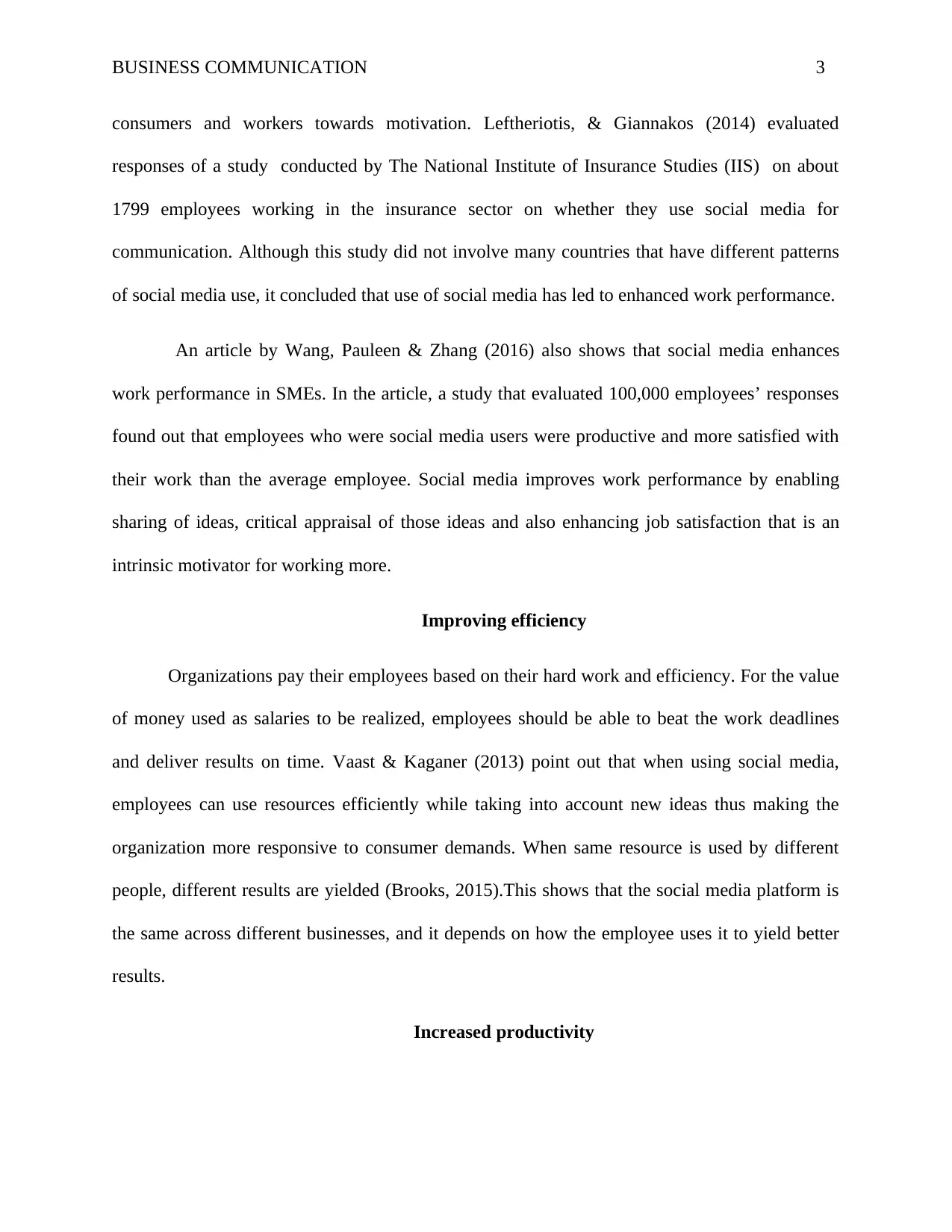
BUSINESS COMMUNICATION 3
consumers and workers towards motivation. Leftheriotis, & Giannakos (2014) evaluated
responses of a study conducted by The National Institute of Insurance Studies (IIS) on about
1799 employees working in the insurance sector on whether they use social media for
communication. Although this study did not involve many countries that have different patterns
of social media use, it concluded that use of social media has led to enhanced work performance.
An article by Wang, Pauleen & Zhang (2016) also shows that social media enhances
work performance in SMEs. In the article, a study that evaluated 100,000 employees’ responses
found out that employees who were social media users were productive and more satisfied with
their work than the average employee. Social media improves work performance by enabling
sharing of ideas, critical appraisal of those ideas and also enhancing job satisfaction that is an
intrinsic motivator for working more.
Improving efficiency
Organizations pay their employees based on their hard work and efficiency. For the value
of money used as salaries to be realized, employees should be able to beat the work deadlines
and deliver results on time. Vaast & Kaganer (2013) point out that when using social media,
employees can use resources efficiently while taking into account new ideas thus making the
organization more responsive to consumer demands. When same resource is used by different
people, different results are yielded (Brooks, 2015).This shows that the social media platform is
the same across different businesses, and it depends on how the employee uses it to yield better
results.
Increased productivity
consumers and workers towards motivation. Leftheriotis, & Giannakos (2014) evaluated
responses of a study conducted by The National Institute of Insurance Studies (IIS) on about
1799 employees working in the insurance sector on whether they use social media for
communication. Although this study did not involve many countries that have different patterns
of social media use, it concluded that use of social media has led to enhanced work performance.
An article by Wang, Pauleen & Zhang (2016) also shows that social media enhances
work performance in SMEs. In the article, a study that evaluated 100,000 employees’ responses
found out that employees who were social media users were productive and more satisfied with
their work than the average employee. Social media improves work performance by enabling
sharing of ideas, critical appraisal of those ideas and also enhancing job satisfaction that is an
intrinsic motivator for working more.
Improving efficiency
Organizations pay their employees based on their hard work and efficiency. For the value
of money used as salaries to be realized, employees should be able to beat the work deadlines
and deliver results on time. Vaast & Kaganer (2013) point out that when using social media,
employees can use resources efficiently while taking into account new ideas thus making the
organization more responsive to consumer demands. When same resource is used by different
people, different results are yielded (Brooks, 2015).This shows that the social media platform is
the same across different businesses, and it depends on how the employee uses it to yield better
results.
Increased productivity
⊘ This is a preview!⊘
Do you want full access?
Subscribe today to unlock all pages.

Trusted by 1+ million students worldwide
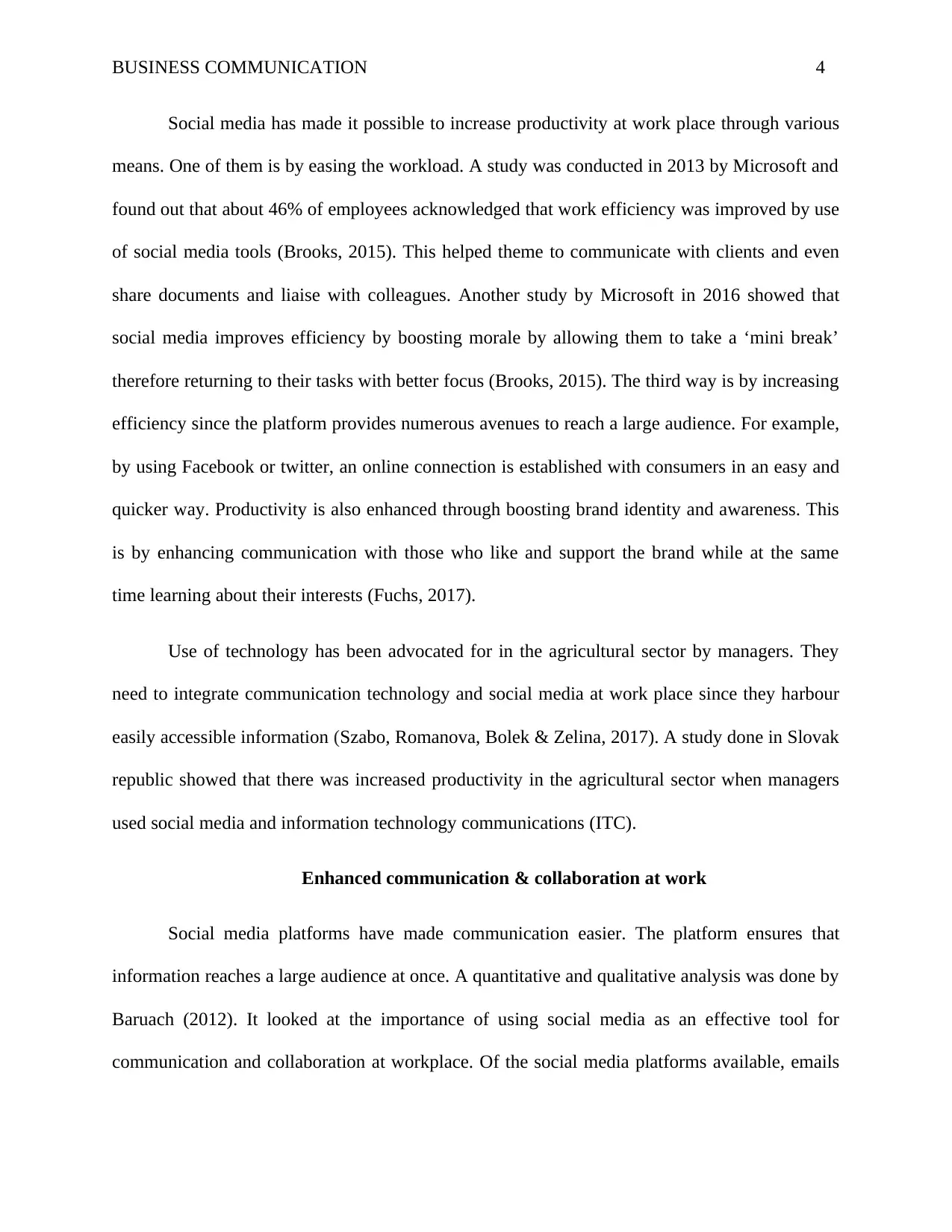
BUSINESS COMMUNICATION 4
Social media has made it possible to increase productivity at work place through various
means. One of them is by easing the workload. A study was conducted in 2013 by Microsoft and
found out that about 46% of employees acknowledged that work efficiency was improved by use
of social media tools (Brooks, 2015). This helped theme to communicate with clients and even
share documents and liaise with colleagues. Another study by Microsoft in 2016 showed that
social media improves efficiency by boosting morale by allowing them to take a ‘mini break’
therefore returning to their tasks with better focus (Brooks, 2015). The third way is by increasing
efficiency since the platform provides numerous avenues to reach a large audience. For example,
by using Facebook or twitter, an online connection is established with consumers in an easy and
quicker way. Productivity is also enhanced through boosting brand identity and awareness. This
is by enhancing communication with those who like and support the brand while at the same
time learning about their interests (Fuchs, 2017).
Use of technology has been advocated for in the agricultural sector by managers. They
need to integrate communication technology and social media at work place since they harbour
easily accessible information (Szabo, Romanova, Bolek & Zelina, 2017). A study done in Slovak
republic showed that there was increased productivity in the agricultural sector when managers
used social media and information technology communications (ITC).
Enhanced communication & collaboration at work
Social media platforms have made communication easier. The platform ensures that
information reaches a large audience at once. A quantitative and qualitative analysis was done by
Baruach (2012). It looked at the importance of using social media as an effective tool for
communication and collaboration at workplace. Of the social media platforms available, emails
Social media has made it possible to increase productivity at work place through various
means. One of them is by easing the workload. A study was conducted in 2013 by Microsoft and
found out that about 46% of employees acknowledged that work efficiency was improved by use
of social media tools (Brooks, 2015). This helped theme to communicate with clients and even
share documents and liaise with colleagues. Another study by Microsoft in 2016 showed that
social media improves efficiency by boosting morale by allowing them to take a ‘mini break’
therefore returning to their tasks with better focus (Brooks, 2015). The third way is by increasing
efficiency since the platform provides numerous avenues to reach a large audience. For example,
by using Facebook or twitter, an online connection is established with consumers in an easy and
quicker way. Productivity is also enhanced through boosting brand identity and awareness. This
is by enhancing communication with those who like and support the brand while at the same
time learning about their interests (Fuchs, 2017).
Use of technology has been advocated for in the agricultural sector by managers. They
need to integrate communication technology and social media at work place since they harbour
easily accessible information (Szabo, Romanova, Bolek & Zelina, 2017). A study done in Slovak
republic showed that there was increased productivity in the agricultural sector when managers
used social media and information technology communications (ITC).
Enhanced communication & collaboration at work
Social media platforms have made communication easier. The platform ensures that
information reaches a large audience at once. A quantitative and qualitative analysis was done by
Baruach (2012). It looked at the importance of using social media as an effective tool for
communication and collaboration at workplace. Of the social media platforms available, emails
Paraphrase This Document
Need a fresh take? Get an instant paraphrase of this document with our AI Paraphraser
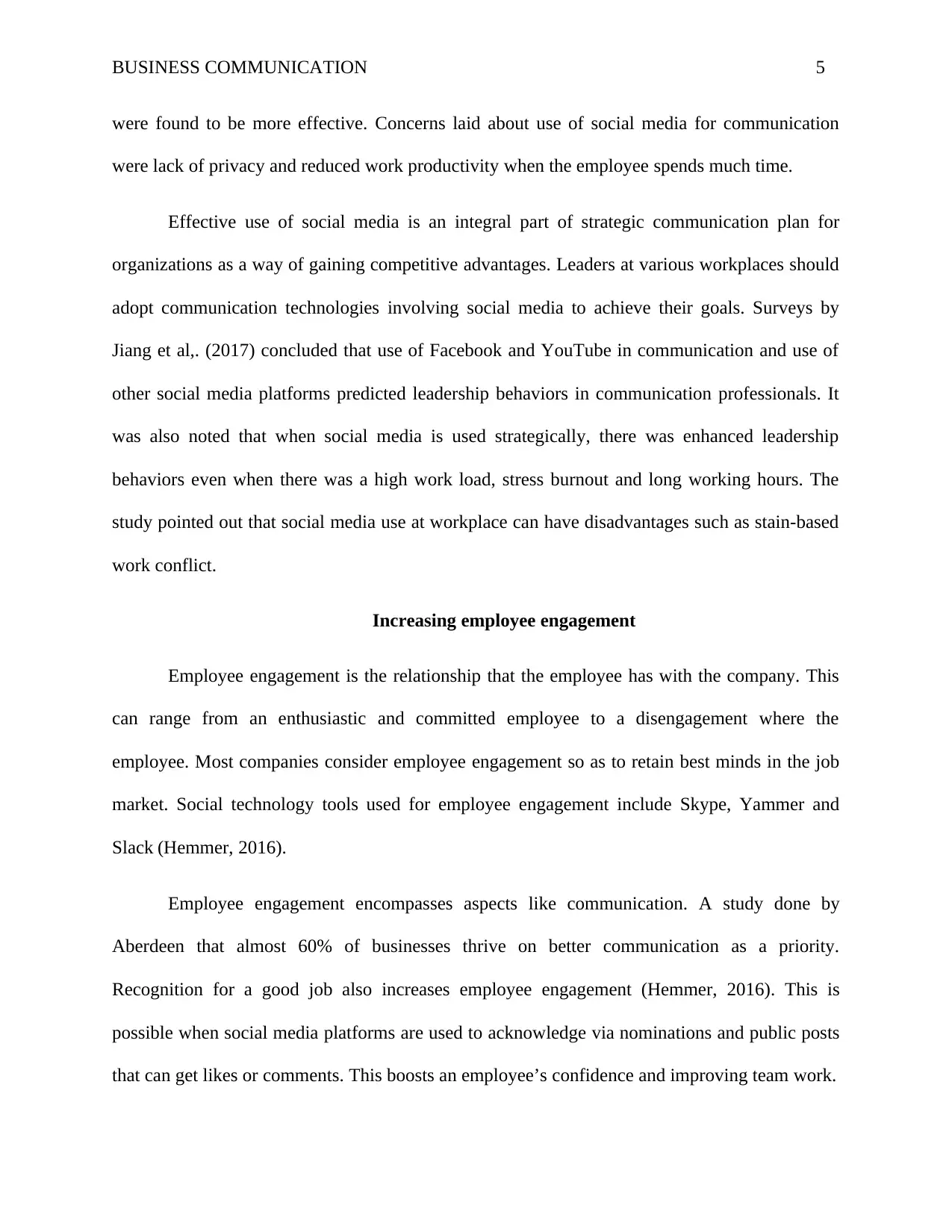
BUSINESS COMMUNICATION 5
were found to be more effective. Concerns laid about use of social media for communication
were lack of privacy and reduced work productivity when the employee spends much time.
Effective use of social media is an integral part of strategic communication plan for
organizations as a way of gaining competitive advantages. Leaders at various workplaces should
adopt communication technologies involving social media to achieve their goals. Surveys by
Jiang et al,. (2017) concluded that use of Facebook and YouTube in communication and use of
other social media platforms predicted leadership behaviors in communication professionals. It
was also noted that when social media is used strategically, there was enhanced leadership
behaviors even when there was a high work load, stress burnout and long working hours. The
study pointed out that social media use at workplace can have disadvantages such as stain-based
work conflict.
Increasing employee engagement
Employee engagement is the relationship that the employee has with the company. This
can range from an enthusiastic and committed employee to a disengagement where the
employee. Most companies consider employee engagement so as to retain best minds in the job
market. Social technology tools used for employee engagement include Skype, Yammer and
Slack (Hemmer, 2016).
Employee engagement encompasses aspects like communication. A study done by
Aberdeen that almost 60% of businesses thrive on better communication as a priority.
Recognition for a good job also increases employee engagement (Hemmer, 2016). This is
possible when social media platforms are used to acknowledge via nominations and public posts
that can get likes or comments. This boosts an employee’s confidence and improving team work.
were found to be more effective. Concerns laid about use of social media for communication
were lack of privacy and reduced work productivity when the employee spends much time.
Effective use of social media is an integral part of strategic communication plan for
organizations as a way of gaining competitive advantages. Leaders at various workplaces should
adopt communication technologies involving social media to achieve their goals. Surveys by
Jiang et al,. (2017) concluded that use of Facebook and YouTube in communication and use of
other social media platforms predicted leadership behaviors in communication professionals. It
was also noted that when social media is used strategically, there was enhanced leadership
behaviors even when there was a high work load, stress burnout and long working hours. The
study pointed out that social media use at workplace can have disadvantages such as stain-based
work conflict.
Increasing employee engagement
Employee engagement is the relationship that the employee has with the company. This
can range from an enthusiastic and committed employee to a disengagement where the
employee. Most companies consider employee engagement so as to retain best minds in the job
market. Social technology tools used for employee engagement include Skype, Yammer and
Slack (Hemmer, 2016).
Employee engagement encompasses aspects like communication. A study done by
Aberdeen that almost 60% of businesses thrive on better communication as a priority.
Recognition for a good job also increases employee engagement (Hemmer, 2016). This is
possible when social media platforms are used to acknowledge via nominations and public posts
that can get likes or comments. This boosts an employee’s confidence and improving team work.
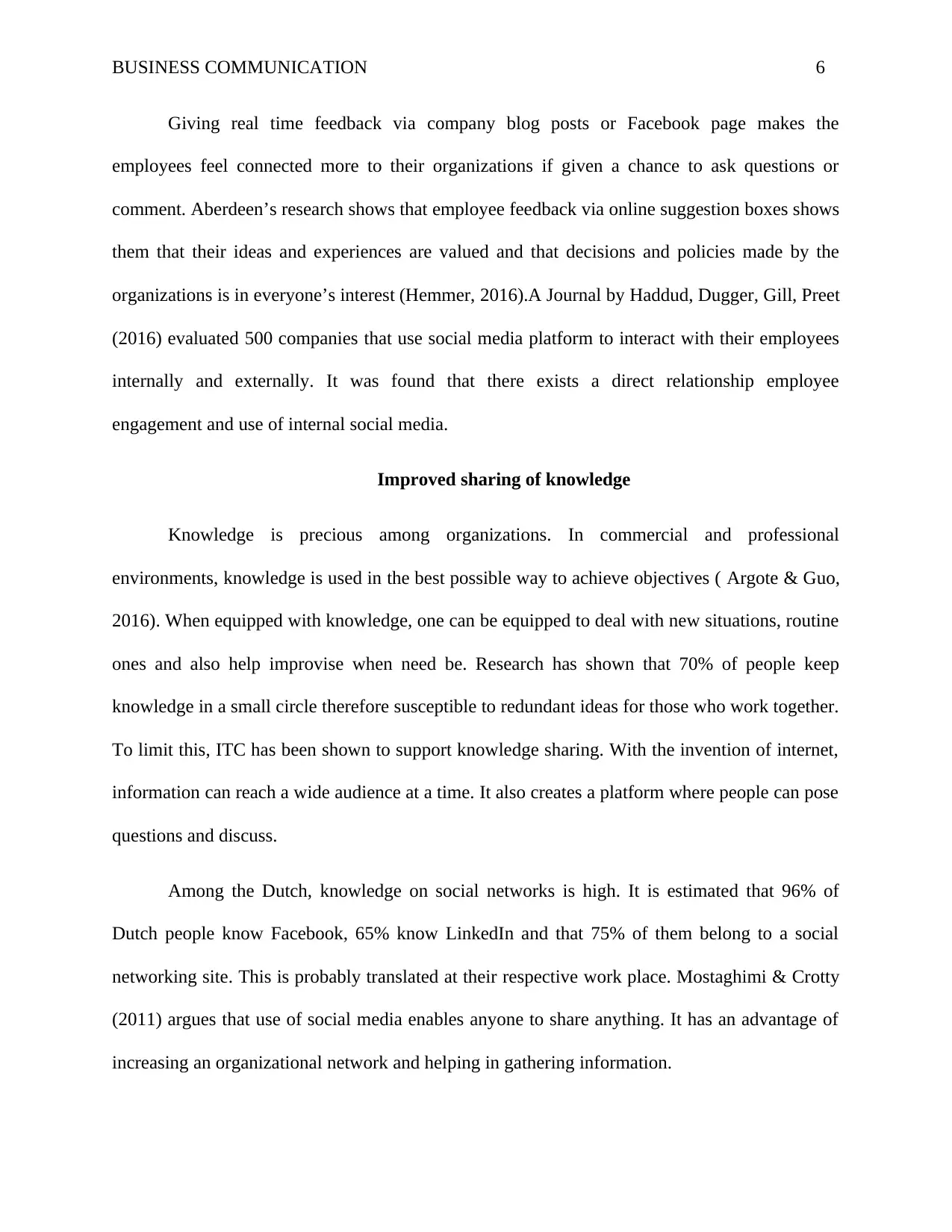
BUSINESS COMMUNICATION 6
Giving real time feedback via company blog posts or Facebook page makes the
employees feel connected more to their organizations if given a chance to ask questions or
comment. Aberdeen’s research shows that employee feedback via online suggestion boxes shows
them that their ideas and experiences are valued and that decisions and policies made by the
organizations is in everyone’s interest (Hemmer, 2016).A Journal by Haddud, Dugger, Gill, Preet
(2016) evaluated 500 companies that use social media platform to interact with their employees
internally and externally. It was found that there exists a direct relationship employee
engagement and use of internal social media.
Improved sharing of knowledge
Knowledge is precious among organizations. In commercial and professional
environments, knowledge is used in the best possible way to achieve objectives ( Argote & Guo,
2016). When equipped with knowledge, one can be equipped to deal with new situations, routine
ones and also help improvise when need be. Research has shown that 70% of people keep
knowledge in a small circle therefore susceptible to redundant ideas for those who work together.
To limit this, ITC has been shown to support knowledge sharing. With the invention of internet,
information can reach a wide audience at a time. It also creates a platform where people can pose
questions and discuss.
Among the Dutch, knowledge on social networks is high. It is estimated that 96% of
Dutch people know Facebook, 65% know LinkedIn and that 75% of them belong to a social
networking site. This is probably translated at their respective work place. Mostaghimi & Crotty
(2011) argues that use of social media enables anyone to share anything. It has an advantage of
increasing an organizational network and helping in gathering information.
Giving real time feedback via company blog posts or Facebook page makes the
employees feel connected more to their organizations if given a chance to ask questions or
comment. Aberdeen’s research shows that employee feedback via online suggestion boxes shows
them that their ideas and experiences are valued and that decisions and policies made by the
organizations is in everyone’s interest (Hemmer, 2016).A Journal by Haddud, Dugger, Gill, Preet
(2016) evaluated 500 companies that use social media platform to interact with their employees
internally and externally. It was found that there exists a direct relationship employee
engagement and use of internal social media.
Improved sharing of knowledge
Knowledge is precious among organizations. In commercial and professional
environments, knowledge is used in the best possible way to achieve objectives ( Argote & Guo,
2016). When equipped with knowledge, one can be equipped to deal with new situations, routine
ones and also help improvise when need be. Research has shown that 70% of people keep
knowledge in a small circle therefore susceptible to redundant ideas for those who work together.
To limit this, ITC has been shown to support knowledge sharing. With the invention of internet,
information can reach a wide audience at a time. It also creates a platform where people can pose
questions and discuss.
Among the Dutch, knowledge on social networks is high. It is estimated that 96% of
Dutch people know Facebook, 65% know LinkedIn and that 75% of them belong to a social
networking site. This is probably translated at their respective work place. Mostaghimi & Crotty
(2011) argues that use of social media enables anyone to share anything. It has an advantage of
increasing an organizational network and helping in gathering information.
⊘ This is a preview!⊘
Do you want full access?
Subscribe today to unlock all pages.

Trusted by 1+ million students worldwide
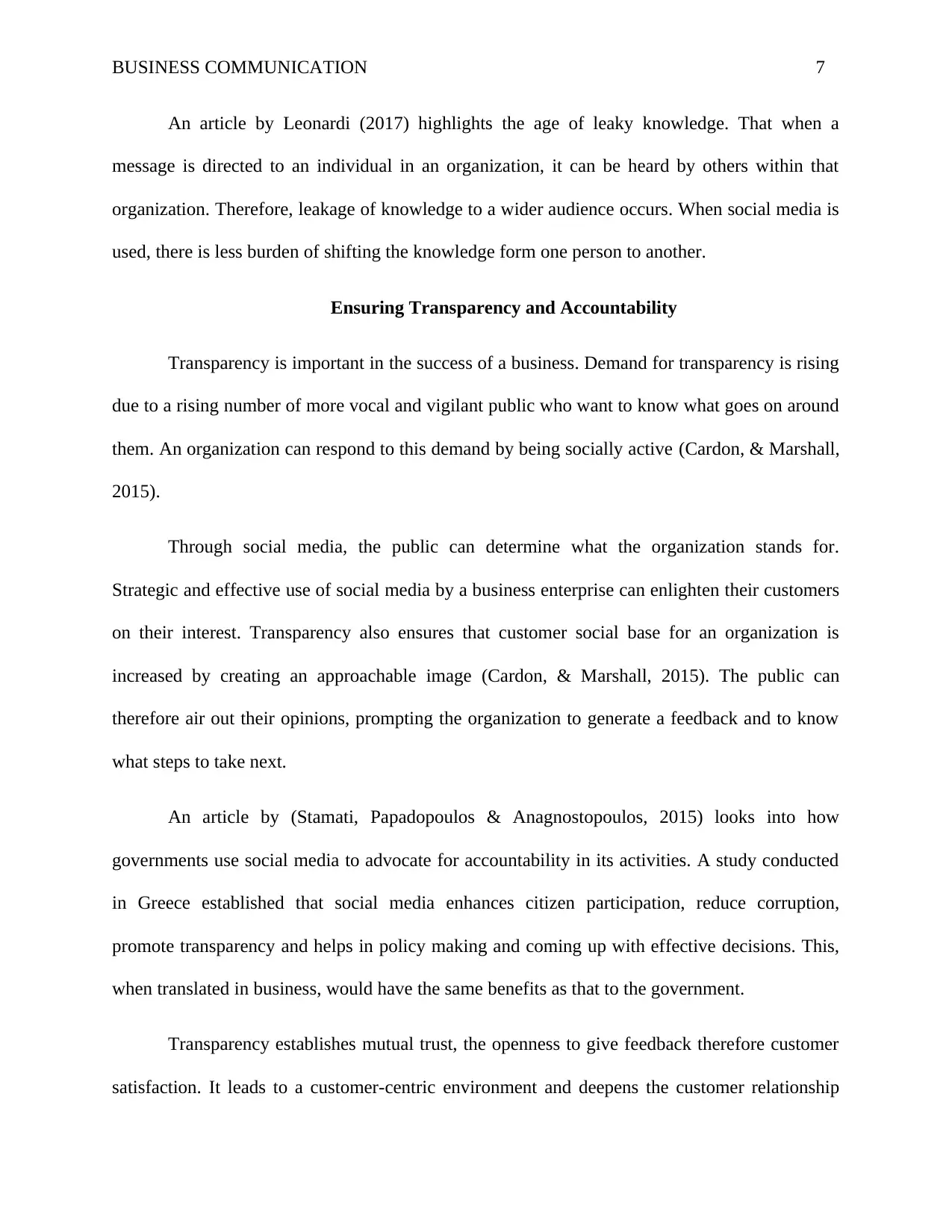
BUSINESS COMMUNICATION 7
An article by Leonardi (2017) highlights the age of leaky knowledge. That when a
message is directed to an individual in an organization, it can be heard by others within that
organization. Therefore, leakage of knowledge to a wider audience occurs. When social media is
used, there is less burden of shifting the knowledge form one person to another.
Ensuring Transparency and Accountability
Transparency is important in the success of a business. Demand for transparency is rising
due to a rising number of more vocal and vigilant public who want to know what goes on around
them. An organization can respond to this demand by being socially active (Cardon, & Marshall,
2015).
Through social media, the public can determine what the organization stands for.
Strategic and effective use of social media by a business enterprise can enlighten their customers
on their interest. Transparency also ensures that customer social base for an organization is
increased by creating an approachable image (Cardon, & Marshall, 2015). The public can
therefore air out their opinions, prompting the organization to generate a feedback and to know
what steps to take next.
An article by (Stamati, Papadopoulos & Anagnostopoulos, 2015) looks into how
governments use social media to advocate for accountability in its activities. A study conducted
in Greece established that social media enhances citizen participation, reduce corruption,
promote transparency and helps in policy making and coming up with effective decisions. This,
when translated in business, would have the same benefits as that to the government.
Transparency establishes mutual trust, the openness to give feedback therefore customer
satisfaction. It leads to a customer-centric environment and deepens the customer relationship
An article by Leonardi (2017) highlights the age of leaky knowledge. That when a
message is directed to an individual in an organization, it can be heard by others within that
organization. Therefore, leakage of knowledge to a wider audience occurs. When social media is
used, there is less burden of shifting the knowledge form one person to another.
Ensuring Transparency and Accountability
Transparency is important in the success of a business. Demand for transparency is rising
due to a rising number of more vocal and vigilant public who want to know what goes on around
them. An organization can respond to this demand by being socially active (Cardon, & Marshall,
2015).
Through social media, the public can determine what the organization stands for.
Strategic and effective use of social media by a business enterprise can enlighten their customers
on their interest. Transparency also ensures that customer social base for an organization is
increased by creating an approachable image (Cardon, & Marshall, 2015). The public can
therefore air out their opinions, prompting the organization to generate a feedback and to know
what steps to take next.
An article by (Stamati, Papadopoulos & Anagnostopoulos, 2015) looks into how
governments use social media to advocate for accountability in its activities. A study conducted
in Greece established that social media enhances citizen participation, reduce corruption,
promote transparency and helps in policy making and coming up with effective decisions. This,
when translated in business, would have the same benefits as that to the government.
Transparency establishes mutual trust, the openness to give feedback therefore customer
satisfaction. It leads to a customer-centric environment and deepens the customer relationship
Paraphrase This Document
Need a fresh take? Get an instant paraphrase of this document with our AI Paraphraser
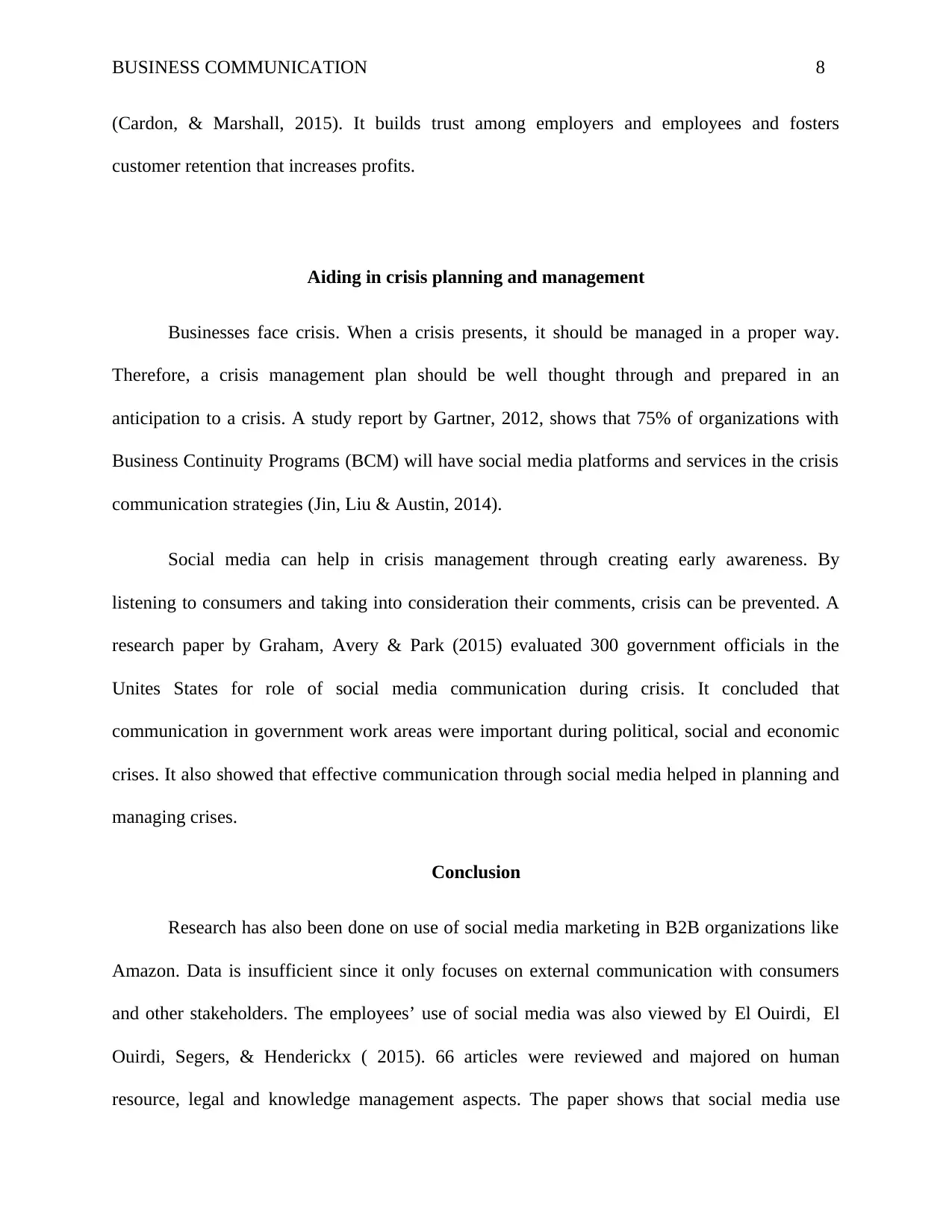
BUSINESS COMMUNICATION 8
(Cardon, & Marshall, 2015). It builds trust among employers and employees and fosters
customer retention that increases profits.
Aiding in crisis planning and management
Businesses face crisis. When a crisis presents, it should be managed in a proper way.
Therefore, a crisis management plan should be well thought through and prepared in an
anticipation to a crisis. A study report by Gartner, 2012, shows that 75% of organizations with
Business Continuity Programs (BCM) will have social media platforms and services in the crisis
communication strategies (Jin, Liu & Austin, 2014).
Social media can help in crisis management through creating early awareness. By
listening to consumers and taking into consideration their comments, crisis can be prevented. A
research paper by Graham, Avery & Park (2015) evaluated 300 government officials in the
Unites States for role of social media communication during crisis. It concluded that
communication in government work areas were important during political, social and economic
crises. It also showed that effective communication through social media helped in planning and
managing crises.
Conclusion
Research has also been done on use of social media marketing in B2B organizations like
Amazon. Data is insufficient since it only focuses on external communication with consumers
and other stakeholders. The employees’ use of social media was also viewed by El Ouirdi, El
Ouirdi, Segers, & Henderickx ( 2015). 66 articles were reviewed and majored on human
resource, legal and knowledge management aspects. The paper shows that social media use
(Cardon, & Marshall, 2015). It builds trust among employers and employees and fosters
customer retention that increases profits.
Aiding in crisis planning and management
Businesses face crisis. When a crisis presents, it should be managed in a proper way.
Therefore, a crisis management plan should be well thought through and prepared in an
anticipation to a crisis. A study report by Gartner, 2012, shows that 75% of organizations with
Business Continuity Programs (BCM) will have social media platforms and services in the crisis
communication strategies (Jin, Liu & Austin, 2014).
Social media can help in crisis management through creating early awareness. By
listening to consumers and taking into consideration their comments, crisis can be prevented. A
research paper by Graham, Avery & Park (2015) evaluated 300 government officials in the
Unites States for role of social media communication during crisis. It concluded that
communication in government work areas were important during political, social and economic
crises. It also showed that effective communication through social media helped in planning and
managing crises.
Conclusion
Research has also been done on use of social media marketing in B2B organizations like
Amazon. Data is insufficient since it only focuses on external communication with consumers
and other stakeholders. The employees’ use of social media was also viewed by El Ouirdi, El
Ouirdi, Segers, & Henderickx ( 2015). 66 articles were reviewed and majored on human
resource, legal and knowledge management aspects. The paper shows that social media use
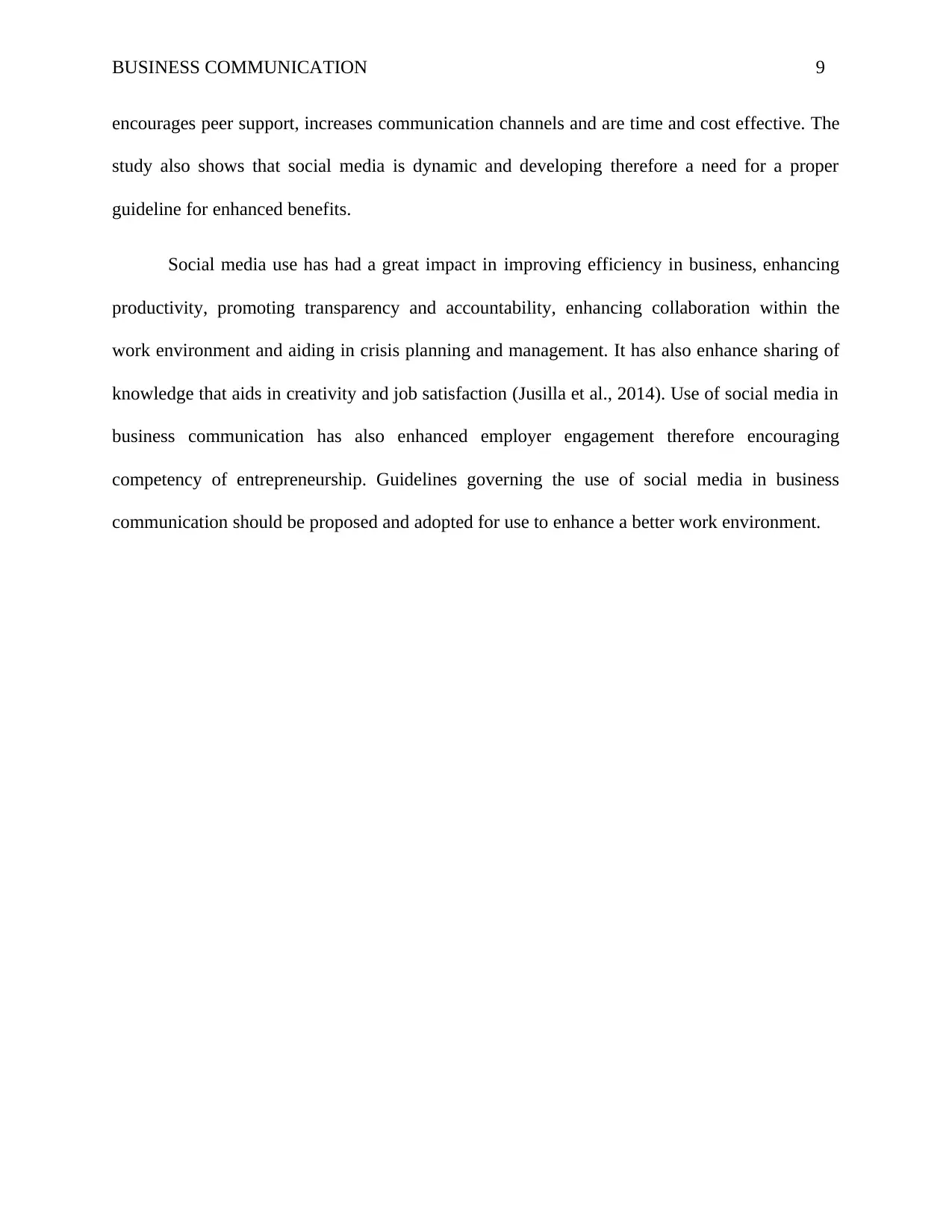
BUSINESS COMMUNICATION 9
encourages peer support, increases communication channels and are time and cost effective. The
study also shows that social media is dynamic and developing therefore a need for a proper
guideline for enhanced benefits.
Social media use has had a great impact in improving efficiency in business, enhancing
productivity, promoting transparency and accountability, enhancing collaboration within the
work environment and aiding in crisis planning and management. It has also enhance sharing of
knowledge that aids in creativity and job satisfaction (Jusilla et al., 2014). Use of social media in
business communication has also enhanced employer engagement therefore encouraging
competency of entrepreneurship. Guidelines governing the use of social media in business
communication should be proposed and adopted for use to enhance a better work environment.
encourages peer support, increases communication channels and are time and cost effective. The
study also shows that social media is dynamic and developing therefore a need for a proper
guideline for enhanced benefits.
Social media use has had a great impact in improving efficiency in business, enhancing
productivity, promoting transparency and accountability, enhancing collaboration within the
work environment and aiding in crisis planning and management. It has also enhance sharing of
knowledge that aids in creativity and job satisfaction (Jusilla et al., 2014). Use of social media in
business communication has also enhanced employer engagement therefore encouraging
competency of entrepreneurship. Guidelines governing the use of social media in business
communication should be proposed and adopted for use to enhance a better work environment.
⊘ This is a preview!⊘
Do you want full access?
Subscribe today to unlock all pages.

Trusted by 1+ million students worldwide
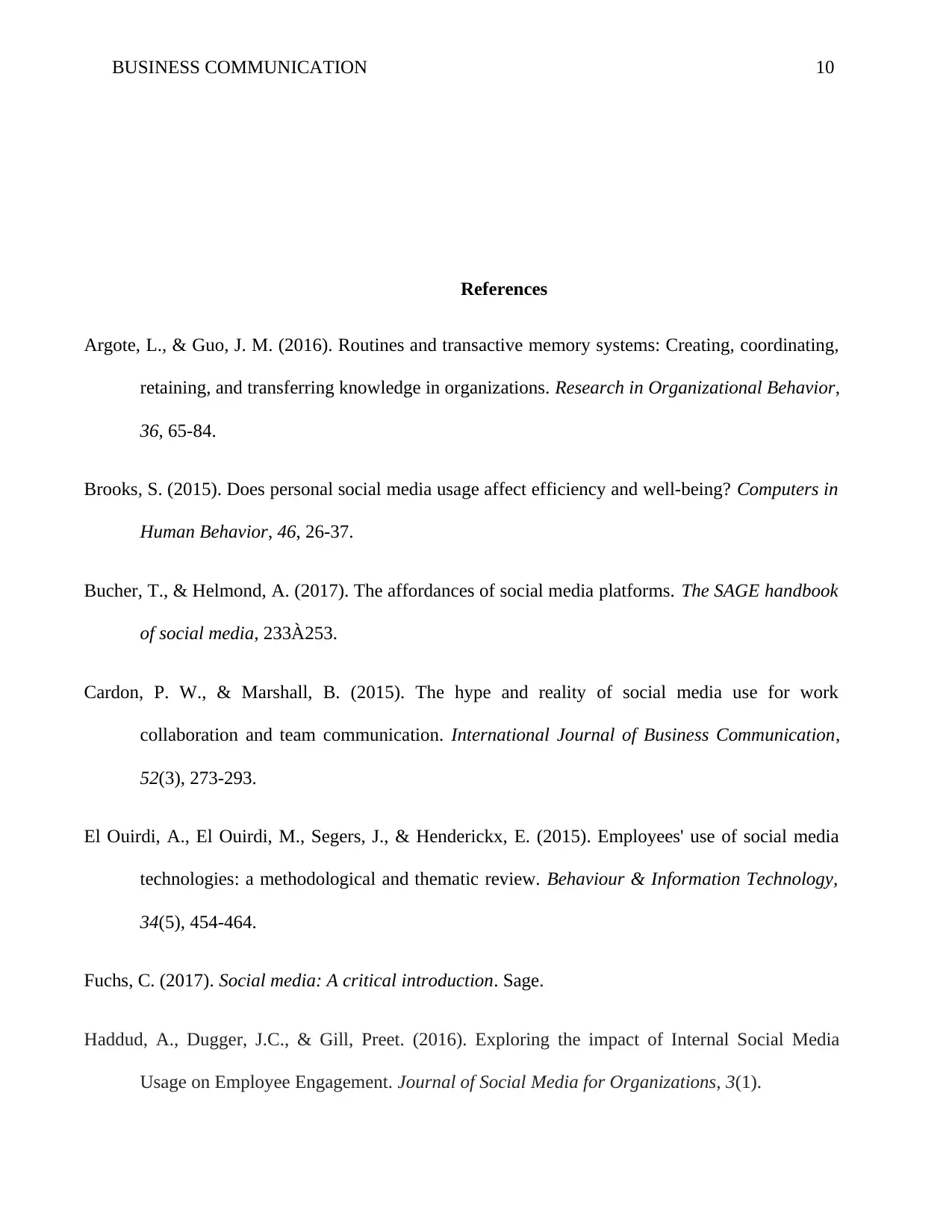
BUSINESS COMMUNICATION 10
References
Argote, L., & Guo, J. M. (2016). Routines and transactive memory systems: Creating, coordinating,
retaining, and transferring knowledge in organizations. Research in Organizational Behavior,
36, 65-84.
Brooks, S. (2015). Does personal social media usage affect efficiency and well-being? Computers in
Human Behavior, 46, 26-37.
Bucher, T., & Helmond, A. (2017). The affordances of social media platforms. The SAGE handbook
of social media, 233À253.
Cardon, P. W., & Marshall, B. (2015). The hype and reality of social media use for work
collaboration and team communication. International Journal of Business Communication,
52(3), 273-293.
El Ouirdi, A., El Ouirdi, M., Segers, J., & Henderickx, E. (2015). Employees' use of social media
technologies: a methodological and thematic review. Behaviour & Information Technology,
34(5), 454-464.
Fuchs, C. (2017). Social media: A critical introduction. Sage.
Haddud, A., Dugger, J.C., & Gill, Preet. (2016). Exploring the impact of Internal Social Media
Usage on Employee Engagement. Journal of Social Media for Organizations, 3(1).
References
Argote, L., & Guo, J. M. (2016). Routines and transactive memory systems: Creating, coordinating,
retaining, and transferring knowledge in organizations. Research in Organizational Behavior,
36, 65-84.
Brooks, S. (2015). Does personal social media usage affect efficiency and well-being? Computers in
Human Behavior, 46, 26-37.
Bucher, T., & Helmond, A. (2017). The affordances of social media platforms. The SAGE handbook
of social media, 233À253.
Cardon, P. W., & Marshall, B. (2015). The hype and reality of social media use for work
collaboration and team communication. International Journal of Business Communication,
52(3), 273-293.
El Ouirdi, A., El Ouirdi, M., Segers, J., & Henderickx, E. (2015). Employees' use of social media
technologies: a methodological and thematic review. Behaviour & Information Technology,
34(5), 454-464.
Fuchs, C. (2017). Social media: A critical introduction. Sage.
Haddud, A., Dugger, J.C., & Gill, Preet. (2016). Exploring the impact of Internal Social Media
Usage on Employee Engagement. Journal of Social Media for Organizations, 3(1).
Paraphrase This Document
Need a fresh take? Get an instant paraphrase of this document with our AI Paraphraser
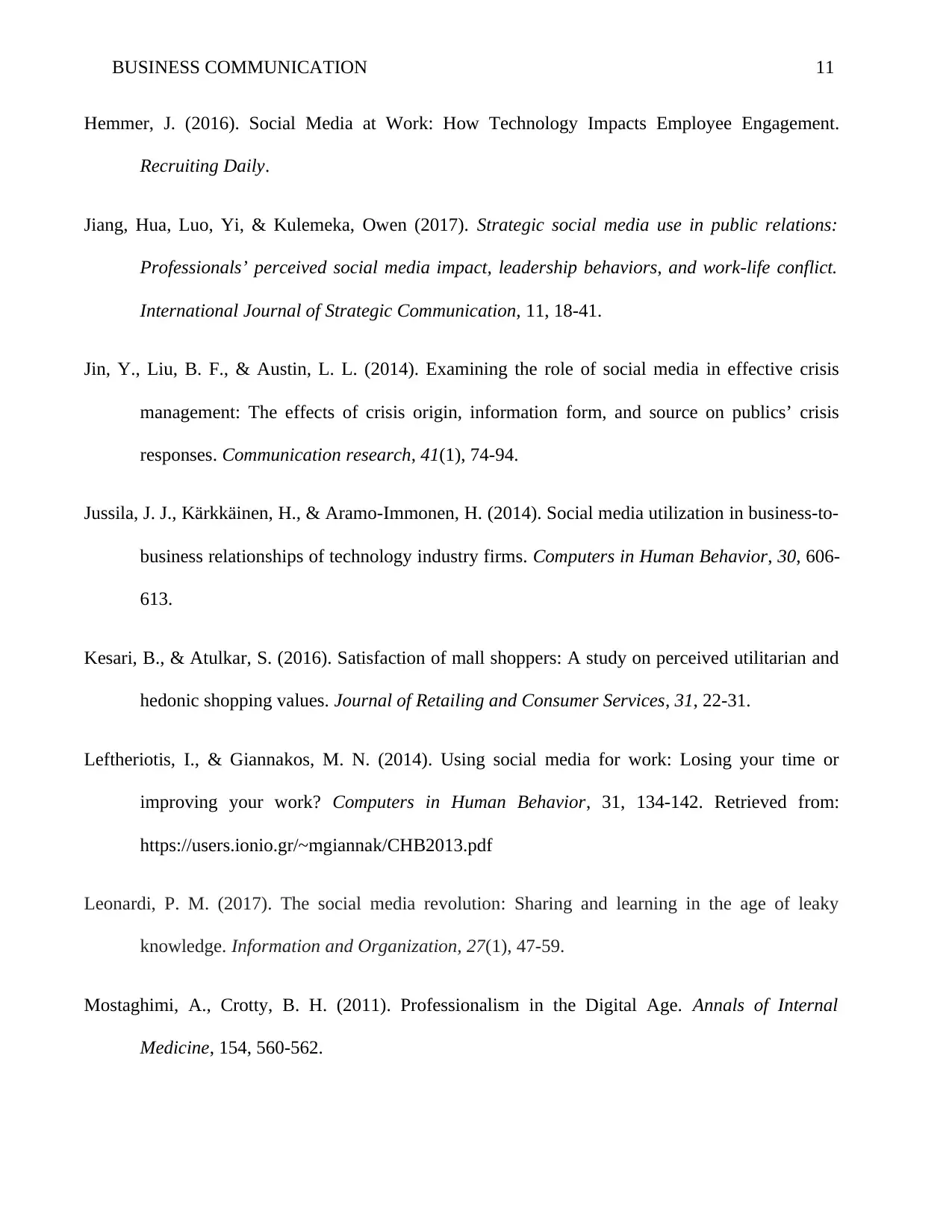
BUSINESS COMMUNICATION 11
Hemmer, J. (2016). Social Media at Work: How Technology Impacts Employee Engagement.
Recruiting Daily.
Jiang, Hua, Luo, Yi, & Kulemeka, Owen (2017). Strategic social media use in public relations:
Professionals’ perceived social media impact, leadership behaviors, and work-life conflict.
International Journal of Strategic Communication, 11, 18-41.
Jin, Y., Liu, B. F., & Austin, L. L. (2014). Examining the role of social media in effective crisis
management: The effects of crisis origin, information form, and source on publics’ crisis
responses. Communication research, 41(1), 74-94.
Jussila, J. J., Kärkkäinen, H., & Aramo-Immonen, H. (2014). Social media utilization in business-to-
business relationships of technology industry firms. Computers in Human Behavior, 30, 606-
613.
Kesari, B., & Atulkar, S. (2016). Satisfaction of mall shoppers: A study on perceived utilitarian and
hedonic shopping values. Journal of Retailing and Consumer Services, 31, 22-31.
Leftheriotis, I., & Giannakos, M. N. (2014). Using social media for work: Losing your time or
improving your work? Computers in Human Behavior, 31, 134-142. Retrieved from:
https://users.ionio.gr/~mgiannak/CHB2013.pdf
Leonardi, P. M. (2017). The social media revolution: Sharing and learning in the age of leaky
knowledge. Information and Organization, 27(1), 47-59.
Mostaghimi, A., Crotty, B. H. (2011). Professionalism in the Digital Age. Annals of Internal
Medicine, 154, 560-562.
Hemmer, J. (2016). Social Media at Work: How Technology Impacts Employee Engagement.
Recruiting Daily.
Jiang, Hua, Luo, Yi, & Kulemeka, Owen (2017). Strategic social media use in public relations:
Professionals’ perceived social media impact, leadership behaviors, and work-life conflict.
International Journal of Strategic Communication, 11, 18-41.
Jin, Y., Liu, B. F., & Austin, L. L. (2014). Examining the role of social media in effective crisis
management: The effects of crisis origin, information form, and source on publics’ crisis
responses. Communication research, 41(1), 74-94.
Jussila, J. J., Kärkkäinen, H., & Aramo-Immonen, H. (2014). Social media utilization in business-to-
business relationships of technology industry firms. Computers in Human Behavior, 30, 606-
613.
Kesari, B., & Atulkar, S. (2016). Satisfaction of mall shoppers: A study on perceived utilitarian and
hedonic shopping values. Journal of Retailing and Consumer Services, 31, 22-31.
Leftheriotis, I., & Giannakos, M. N. (2014). Using social media for work: Losing your time or
improving your work? Computers in Human Behavior, 31, 134-142. Retrieved from:
https://users.ionio.gr/~mgiannak/CHB2013.pdf
Leonardi, P. M. (2017). The social media revolution: Sharing and learning in the age of leaky
knowledge. Information and Organization, 27(1), 47-59.
Mostaghimi, A., Crotty, B. H. (2011). Professionalism in the Digital Age. Annals of Internal
Medicine, 154, 560-562.
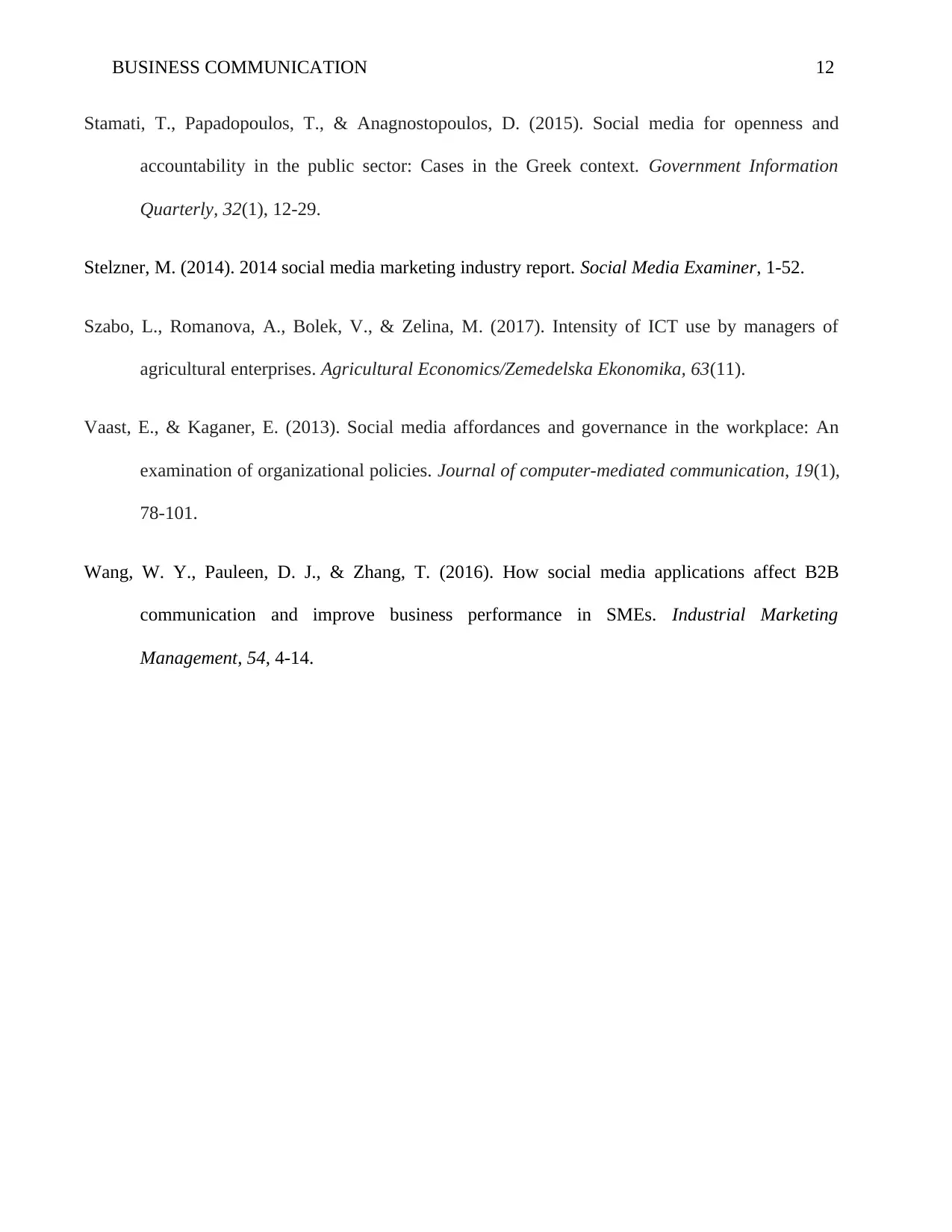
BUSINESS COMMUNICATION 12
Stamati, T., Papadopoulos, T., & Anagnostopoulos, D. (2015). Social media for openness and
accountability in the public sector: Cases in the Greek context. Government Information
Quarterly, 32(1), 12-29.
Stelzner, M. (2014). 2014 social media marketing industry report. Social Media Examiner, 1-52.
Szabo, L., Romanova, A., Bolek, V., & Zelina, M. (2017). Intensity of ICT use by managers of
agricultural enterprises. Agricultural Economics/Zemedelska Ekonomika, 63(11).
Vaast, E., & Kaganer, E. (2013). Social media affordances and governance in the workplace: An
examination of organizational policies. Journal of computer-mediated communication, 19(1),
78-101.
Wang, W. Y., Pauleen, D. J., & Zhang, T. (2016). How social media applications affect B2B
communication and improve business performance in SMEs. Industrial Marketing
Management, 54, 4-14.
Stamati, T., Papadopoulos, T., & Anagnostopoulos, D. (2015). Social media for openness and
accountability in the public sector: Cases in the Greek context. Government Information
Quarterly, 32(1), 12-29.
Stelzner, M. (2014). 2014 social media marketing industry report. Social Media Examiner, 1-52.
Szabo, L., Romanova, A., Bolek, V., & Zelina, M. (2017). Intensity of ICT use by managers of
agricultural enterprises. Agricultural Economics/Zemedelska Ekonomika, 63(11).
Vaast, E., & Kaganer, E. (2013). Social media affordances and governance in the workplace: An
examination of organizational policies. Journal of computer-mediated communication, 19(1),
78-101.
Wang, W. Y., Pauleen, D. J., & Zhang, T. (2016). How social media applications affect B2B
communication and improve business performance in SMEs. Industrial Marketing
Management, 54, 4-14.
⊘ This is a preview!⊘
Do you want full access?
Subscribe today to unlock all pages.

Trusted by 1+ million students worldwide
1 out of 12
Related Documents
Your All-in-One AI-Powered Toolkit for Academic Success.
+13062052269
info@desklib.com
Available 24*7 on WhatsApp / Email
![[object Object]](/_next/static/media/star-bottom.7253800d.svg)
Unlock your academic potential
Copyright © 2020–2025 A2Z Services. All Rights Reserved. Developed and managed by ZUCOL.



